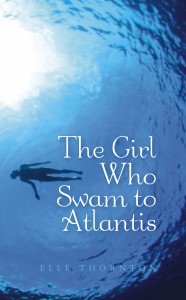Once in a while, a truly remarkable book comes along. The writing is so deep, so beautiful, that you’re left breathless. The Girl Who Swam to Atlantis is just such a book. Crafted with a deft hand, author Elle Thornton delivers a tender, powerful coming-of-age tale filled with unforgettable characters. In 2009, the book received a first place Florida Writers Association Royal Palm Literary Award in the YA (prepublication) category. A former newspaper reporter, Thornton’s poetry has been published in The Connecticut River Review and The Concho River Review. Needless to say, I had to interview her.
Silverberry: What gave you the idea for The Girl Who Swam to Atlantis?
Thornton: I’d written a few pages that matched how I thought characters should speak and act in a YA book. But those characters I crafted never did come to life the way the ones had in all the fine books I’d read. And I’d read stacks of them. It took a while, but I realized that in the best books, the characters made me feel: fear, hurt, anger, happiness, liking, love. I felt deeply for them. That’s when I started trying to write about characters that made me feel, and that’s when Gabriella and Hawkins showed up. They emerged in the way images used to on paper in a photo lab, faint at first, then appearing more clearly. I first saw Gabriella and Hawkins standing beside a river. Hawkins was fishing, Gabriella asking him questions. All around them I sensed that heat of a southern summer, the salt wind off the river, the sound of cicadas, the scream of fighter jets. I felt that desperate longing to talk with someone and have them listen. I like to think all this found a place in the book. As Gabriella and Hawkins got to know each other, they led me to Emmett Till; the three of them told me their story.
Silverberry: What’s the story about?
Thornton: The savagely murdered youth Emmett Till comes to life in twelve-year-old Gabriella’s heart when an African-American Marine, Hawkins, teaches the lonely girl to swim in a North Carolina river.
Silverberry: The story has a powerful sense of place. How did you develop that?
Thornton: I’m so glad you feel that way! What I did was try to recollect the sights and sounds of a military base I’d lived on. It was located near a beautiful tidal river, a wide river lined on either side by thick forest where cicadas and the wind sang. Add to this the sight and sound of attack jets howling overhead and big guns booming, and a place finds its way into your blood. And onto a page.
Silverberry: Your characters were so compelling and real. How did you develop them?
Thornton: I liked Gabriella and Hawkins so much when they showed up that I wanted to learn more. When I wrote dialogue between them I listened to and felt what they said. Also, during much of the time I wrote this story, I belonged to writing groups, first in Illinois and then in Florida. My writing friends asked questions; their questions prompted me to flesh out aspects of character that needed development.
Silverberry: What was your approach to crafting the plot?
Thornton: For the time and place of this story––1950s in the south––race relations had to be at its core. So I knew the story would deal with race, but exactly what form it would take was unclear to me at the outset. I had a handful of story threads: race, longing, anger, love and loss, along with swimming, the military, emotional illness, and heroes: I didn’t know how to bring them together to form a whole. When a student of mine mentioned she’d attended a school where Mamie Till-Mobley of Chicago taught––Emmett Till’s mother––I recognized Emmett’s name but realized I didn’t really know anything about him and that I truly needed to. What I learned about Emmett was heartbreaking, and it’s stayed with me and always will. Emmett helped me weave the threads of the plot together.
Silverberry: In what ways did “Write what you know” enter into the writing process?
Thornton: In many ways I did write what I knew because I believe the really important things I wrote about were emotions. In addition, I knew about life in the 1950s in the south on a military base, the sights and sounds, and I felt comfortable with that.
Silverberry: What is your approach to research, and how much did you do?
Thornton: Since my student spoke to me about Emmett, I’ve read many books and articles about him. Some of the material is listed on the first page of my website. I also watched a DVD by director Keith A. Beauchamp, “The Untold Story of Emmett Louis Till.” Another excellent resource is “The Murder of Emmett Till: The Brutal Killing That Mobilized the Civil Rights Movement” directed by Stanley Nelson and available at here.
A very important part of my research relating to Hawkins was made possible by the United States Marine Corps: its History and Museums Division has published an excellent book, Blacks in the Marine Corps by Henry I. Shaw, Jr. and Ralph W. Donnelly. I‘ve read it several times.
Silverberry: What advice would you give to developing writers?
Thornton: Pay close attention to what your imagination and heart tell you. Have faith in both, be true to them, and follow their lead.
Silverberry: What’s ahead for you?
Thornton: I’ve written a YA mystery that needs revision. Once I’ve done that, I plan to upload it to Goodreads in hopes of getting advice from readers. My thoughts often turn to Gabriella and Hawkins. I’d love to hear from visitors to this blog, so please leave a comment here or on my website.
Silverberry: Thanks so much for stopping by, Elle. Readers can purchase The Girl Who Swam to Atlantis on Amazon. And watch my contest page. In August, Elle’s book will be part of Silverberry’s Young Adult Book Contest! Don’t miss your chance to win!


